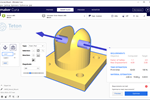Smart Slice simulation software now available from Dynamism
3D printing solutions provider Dynamism now offers optimization plugin Smart Slice from Teton Simulation.

3D printing solutions provider Dynamism (Chicago, Ill. and Denver, Colo., U.S.) announced on Feb. 2 that it has expanded into Industry 4.0 software with the addition of Teton Simulation Software’s (Layramie, Wyo., U.S.) Smart Slice, an Ultimaker Cura slicing software plugin that uses cloud-based finite element analysis (FEA) to optimize print parameters in order to create parts that meet performance requirements while reducing printing times and material usage.
“As a leading provider of 3D printing solutions, it is important that we provide end-to-end solutions for professionals. This includes 3D scanners, materials, coaching from 3D printing specialists and now software,” says Douglas Krone, CEO of Dynamism.
Launched in September 2020, the Smart Slice plugin was developed as a solution for better visibility into the performance of 3D-printed end-use part, jigs and fixtures and concept parts. According to Teton Simulation, optimization Smart Slice results in material cost savings and time savings from having to reprint or redesign parts.
Mike Metz, CEO of Teton Simulation Software, adds, “Our Smart Slice technology was built from the ground up to give 3D printer operators near instant feedback on the viability of their project. Plus, our optimization feature takes the guesswork out of determining the right slicing parameters. We do all the work, so the user doesn’t have to. All of this capability is provided within the slicer, making it very easy to use.”
Related Content
-
3D-printed CFRP tools for serial production of composite landing flaps
GKN Aerospace Munich and CEAD develop printed tooling with short and continuous fiber that reduces cost and increases sustainability for composites production.
-
TU Munich develops cuboidal conformable tanks using carbon fiber composites for increased hydrogen storage
Flat tank enabling standard platform for BEV and FCEV uses thermoplastic and thermoset composites, overwrapped skeleton design in pursuit of 25% more H2 storage.
-
Large-format 3D printing enables toolless, rapid production for AUVs
Dive Technologies started by 3D printing prototypes of its composite autonomous underwater vehicles, but AM became the solution for customizable, toolless production.

.jpg;width=70;height=70;mode=crop)





.jpg;maxWidth=300;quality=90)




